Last updated on
Discover effective strategies to keep your feline companions from lounging on your couch, ensuring a fur-free and well-maintained living space.
Do you love your furry feline friend, but not so much the scratches they leave on your couch? You’re not alone. Many cat owners struggle with keeping their cats off the furniture, and it can be a frustrating and ongoing battle.
But fear not! With a few simple tips and tricks, you can train your cat to stay off the couch and keep your furniture scratch-free. In this article, we’ll explore some effective methods for keeping cats off couches without resorting to drastic measures like declawing or punishment.
So grab a cup of tea (or catnip) and let’s get started!
Table of Contents
Understanding Cat Behavior

Cats are fascinating creatures with unique personalities and behaviors. Understanding your cat’s behavior is crucial to keeping them off the couch.
Cats love to scratch, stretch, and climb on things, which makes furniture an attractive target for their claws. However, it’s important to remember that cats don’t scratch out of spite or malice; they do it because it’s a natural instinct that helps them mark their territory and keep their claws healthy.
Another common reason why cats may jump on the couch is simply because they enjoy being close to you. Cats are social animals who crave attention from their owners and often seek out cozy spots near humans as a way of bonding.
By understanding your cat’s behavior patterns, you can begin implementing strategies that will help keep them off the couch without causing stress or anxiety for either party involved.
Establishing Boundaries

Establishing boundaries is crucial in training your cat to stay off the couch. One way to do this is by providing them with their own designated space where they can relax and play without interfering with your furniture.
Start by setting up a comfortable bed or mat for your cat in a quiet corner of the room. Place some toys nearby, so they have something to keep them occupied when you’re not around.
It’s also essential to be consistent with enforcing these boundaries. If you catch your cat lounging on the couch, gently pick them up and place them back onto their designated spot while saying “no” firmly but calmly.
Remember that cats respond best to positive reinforcement rather than punishment, so make sure you reward good behavior whenever possible.
Implementing Training Techniques

One of the most effective ways to train a cat is through positive reinforcement. This means rewarding good behavior and ignoring bad behavior.
One popular method for training cats is using a clicker. A clicker is a small device that makes a clicking sound when pressed, which signals to your cat that they have done something right.
To use this technique, simply press the clicker when your cat exhibits good behavior (such as staying off the couch) and immediately reward them with treats or praise.
Another way to reinforce positive behaviors is by providing alternatives for your feline friend. Cats love scratching surfaces because it helps them stretch their muscles and sharpen their claws; therefore, providing an alternative surface like a scratching post or tree can help redirect their attention away from furniture.
Training Your Cat With A Clicker
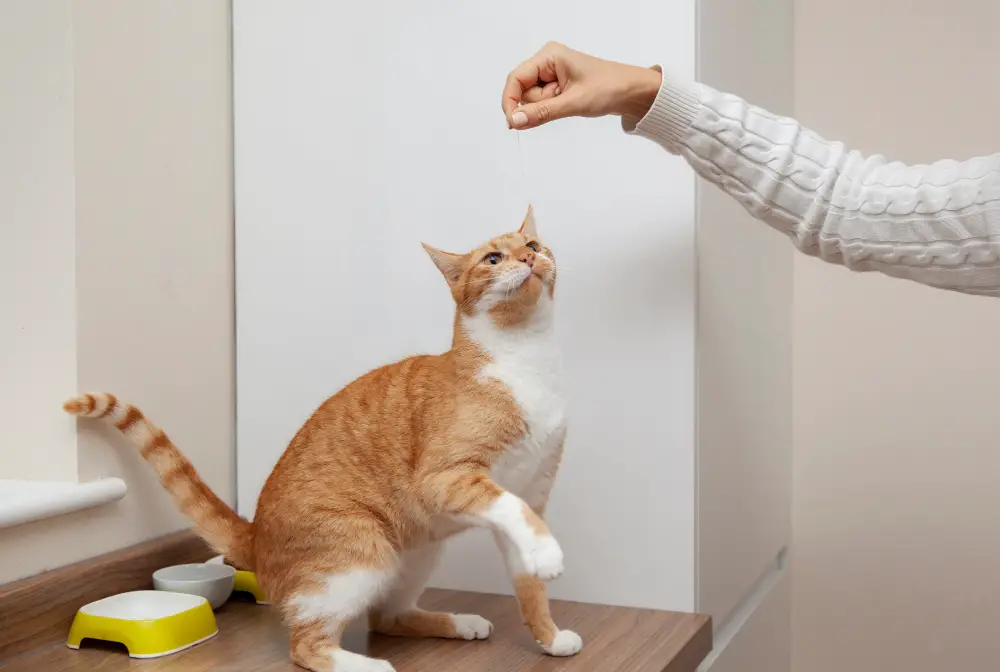
The clicker is a small device that makes a distinct clicking sound when pressed, which serves as an audible marker to let your cat know they have done something right. This positive reinforcement technique can be used to teach your cat all sorts of things, from basic commands like “sit” and “stay” to more complex tricks like jumping through hoops or playing dead.
To start clicker training with your cat, you’ll need some treats that they really love and a quiet space where you won’t be interrupted. Begin by clicking the clicker once and immediately giving them a treat.
Repeat this several times until your cat associates the sound of the click with receiving food.
Next, choose one behavior you want to train them on – perhaps staying off the couch -and wait for them to exhibit it naturally (e.g., jump down from couch). As soon as they do so successfully without being prompted or lured away using treats say “good” followed by pressing/clicking on their favorite toy then give him/her his/her favorite treat immediately after.
Repeat this process consistently over time until he/she learns what’s expected of him/her whenever he/she hears “good” followed by pressing/clicking on their favorite toy then give him/her his/her favorite treat immediately after.
Rewarding Good Behavior

Positive reinforcement can go a long way in training your cat to stay away from furniture and focus on their designated spaces. When your cat uses their scratching post or lounges on their bed instead of the couch, reward them with treats or praise.
Cats respond well to positive reinforcement, so it’s important to make sure you’re rewarding them consistently for good behavior. You can also use clicker training as a way of reinforcing positive behaviors and teaching new ones.
Remember that consistency is key when it comes to training your cat. If you want them to stay off the couch, make sure they have comfortable alternatives like a cozy bed or scratch post nearby.
Providing Alternatives
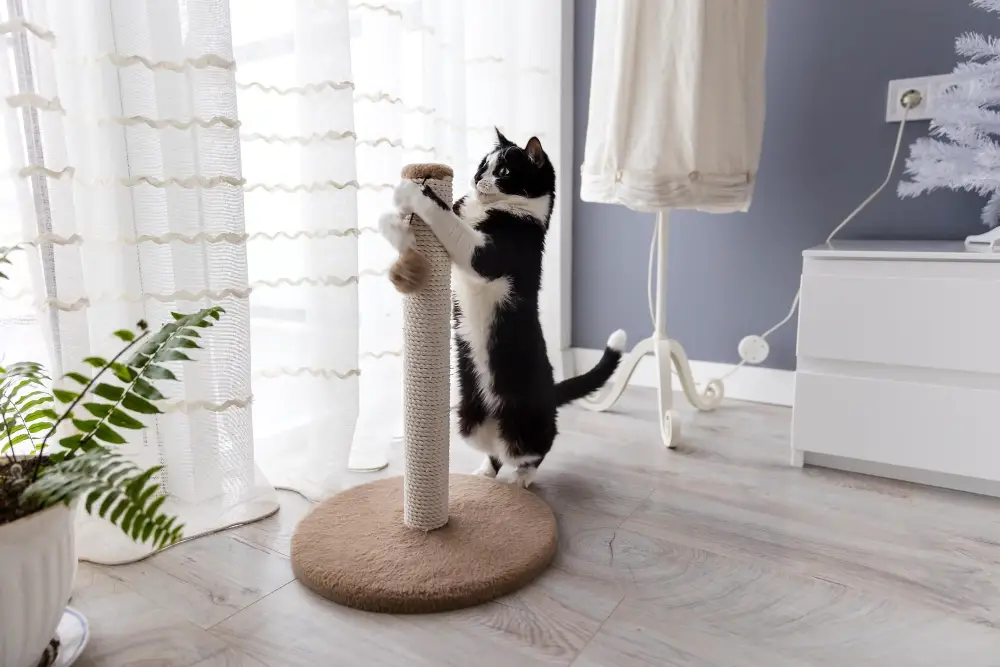
Instead of trying to stop them from scratching altogether, provide alternatives that will satisfy their need for scratching while keeping your furniture safe. A cat tree or a scratching post is an excellent alternative for cats who love to scratch vertically.
These items come in various sizes and shapes, so you can choose one that fits your space and your cat’s preferences.
If you have limited space or prefer something more discreet, consider a horizontal cardboard scratcher or mat. These are inexpensive options that can be placed on the floor next to the couch or other furniture pieces where your cat likes to lounge.
Another way of providing alternatives is by creating comfortable spaces specifically designed for cats’ needs around the house. Cats enjoy having cozy spots where they can relax undisturbed; this could be as simple as placing a soft blanket on top of a bookshelf near the window with access via stairs.
Cat Tree Or Scratching Post
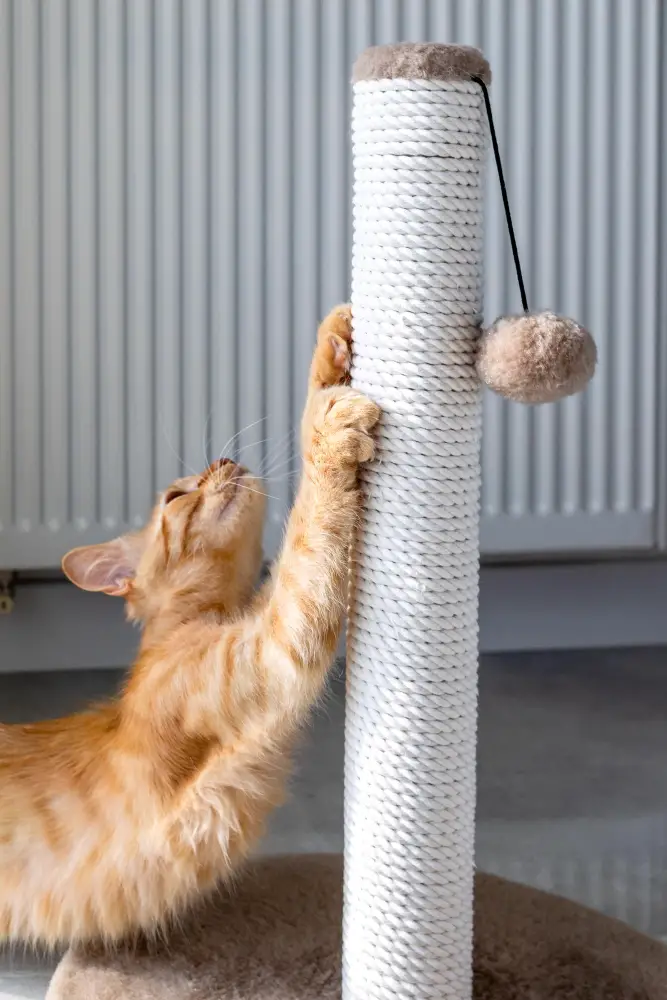
Providing your cat with a designated scratching post or cat tree can help redirect their scratching away from your furniture. A good quality scratching post should be tall enough for the cat to stretch out fully and sturdy enough not to tip over when in use.
A cat tree is another great option that provides multiple levels for climbing, playing, and lounging. It also gives cats a sense of ownership over their space while keeping them off your couch.
When choosing a scratching post or cat tree, consider the material used as well. Sisal rope is an excellent choice because it’s durable and rough-textured – perfect for satisfying those claw-sharpening needs! Avoid using carpeted posts as they may encourage cats to scratch other carpets in the house.
Ensuring Comfortable Spaces
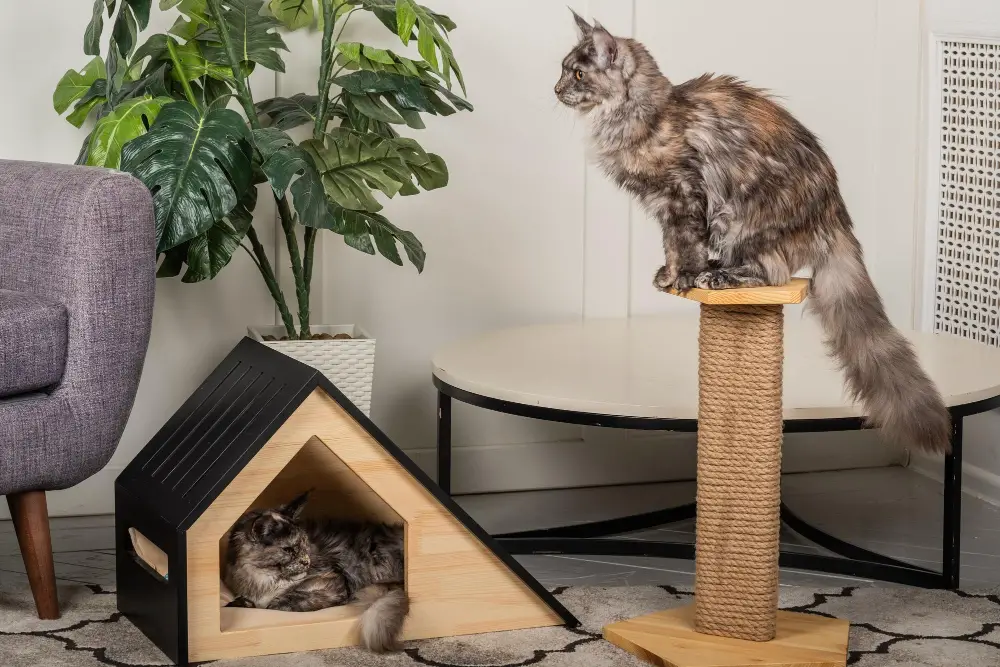
To prevent this from happening, it’s important to provide your cat with comfortable spaces of their own. This can include a cozy bed or blanket in a quiet corner of the room or even investing in a cat tree or scratching post.
Cat trees are great because not only do they provide an elevated space for cats to perch on and survey their surroundings but also offer them opportunities for playtime and exercise. Scratching posts are essential too since cats need an outlet for scratching that isn’t your furniture.
When choosing furniture pieces like beds or blankets, make sure you select materials that are soft yet durable enough to withstand regular use by your furry friend. You can also add some toys around these areas so that there is always something nearby for them when they want some entertainment.
Feline-friendly Furniture

There are ways to make your furniture more feline-friendly and less appealing for scratching. One option is investing in cat-friendly furniture that’s designed with cats in mind.
Cat-friendly furniture typically features materials that are durable enough to withstand scratches and easy-to-clean fabrics like microfiber or leather. Some pieces of cat-specific furnishings come equipped with built-in scratching posts or hiding spots for your furry friend.
If you’re not ready to invest in new feline-focused furnishings just yet, consider covering existing pieces of furniture with slipcovers made from sturdy materials like canvas or denim. These covers can be easily removed and washed when needed while protecting the underlying upholstery from damage caused by sharp claws.
Using Cat Repellents

There are several types of cat repellents available on the market that can help keep cats away from furniture and other areas of your home.
One option is a spray deterrent that uses natural scents like citrus or lavender to repel cats. These sprays are safe for both humans and pets, but it’s important to test them in an inconspicuous area first before applying them liberally.
Another option is motion-activated devices that emit high-pitched sounds or bursts of air when triggered by movement. These devices startle cats without harming them and can be effective at keeping them away from certain areas.
There are also physical barriers like double-sided tape or aluminum foil that can be placed on furniture surfaces as a deterrent. Cats don’t like the feel of these materials under their paws and will often avoid jumping onto surfaces covered with them.
Homemade Spray
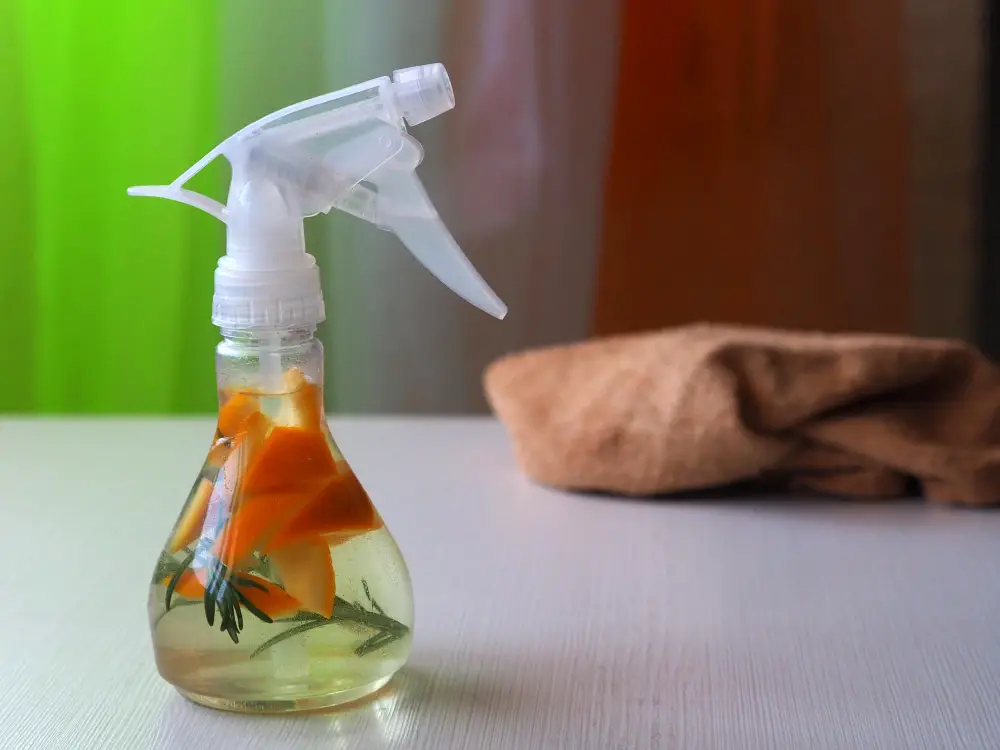
These sprays are easy to make and use ingredients that are safe for both cats and humans.
One popular recipe involves mixing equal parts water and apple cider vinegar in a spray bottle. Simply shake the bottle well before using it on your furniture or other areas where you want to discourage your cat from scratching or lounging.
Another option is citrus spray, which uses lemon or orange essential oil mixed with water in a spray bottle. Cats generally dislike citrus scents, so this can be an effective deterrent without harming them.
It’s important to note that while these homemade sprays may work well for some cats, they may not be effective for all felines. It’s always best to test any new product on a small area of furniture first before applying it more broadly.
In addition to using homemade sprays as part of your anti-scratching strategy, providing alternative surfaces like scratching posts or pads can also help redirect their behavior away from damaging furniture.
Try Citrus Spray

Cats are known to dislike the smell of citrus, making it an excellent deterrent for them. To make this spray, you’ll need some fresh citrus fruits like lemons or oranges and water.
Start by slicing the fruit into thin pieces and placing them in a pot with enough water to cover them completely. Bring the mixture to a boil, then reduce heat and let it simmer for about 20 minutes until all the oils have been released from the fruit.
Once done, strain out any solids using cheesecloth or a fine-mesh strainer. Pour your homemade citrus spray into a clean bottle with an atomizer nozzle that can be used as needed on your furniture.
Spray this solution onto areas where you don’t want your cat scratching or lounging on such as couches, chairs or curtains regularly until they learn not to go near those places anymore.
Make Apple Cider Vinegar Spray

The strong scent of apple cider vinegar repels cats, making it an effective deterrent for keeping them away from furniture. To make the spray, mix equal parts water and apple cider vinegar in a spray bottle.
Shake well before use and apply the solution generously on areas where your cat likes to scratch or lounge.
It’s important to note that while this method is effective, it may not work for all cats as some may be more tolerant of the smell than others. You should test the solution on an inconspicuous area first before applying it liberally throughout your home.
Incorporating natural remedies like apple cider vinegar into your cat training routine can help create a comfortable living space for both you and your furry friend without resorting to harsher methods such as declawing or punishment.
Utilizing Scents

One effective scent is citrus. Cats dislike the smell of oranges, lemons, and grapefruits.
You can use this to your advantage by placing orange or lemon peels on your couch or spraying a citrus-scented spray in the area where you want to keep your cat away.
Another scent that cats find unpleasant is apple cider vinegar (ACV). Mix equal parts ACV and water in a spray bottle and apply it directly onto surfaces you want to protect from scratching or lounging.
It’s important not to use strong-smelling chemicals as they may harm both humans and pets alike. Instead, opt for natural remedies like essential oils diluted with water.
Applying Surface Deterrents
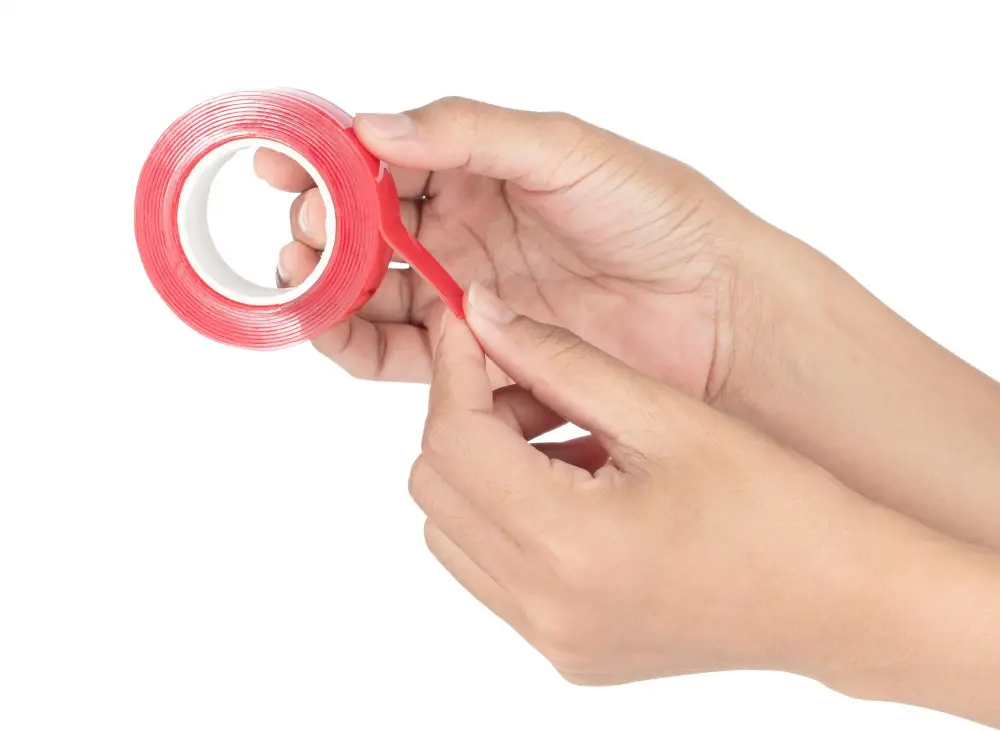
These are materials that make it uncomfortable for your cat to sit or scratch on the couch, without causing any harm. Here are some common surface deterrents you can try:
- Aluminum foil: Cats dislike the sound and texture of aluminum foil, so covering your couch with it can discourage them from jumping on it.
- Plastic carpet runners: Placing plastic carpet runners upside down on your couch will create an uneven surface that cats won’t want to walk or lay on.
- Double-sided tape: Applying double-sided tape onto areas where your cat likes to scratch will deter them from doing so as they don’t like sticky surfaces.
It’s important to note that while these methods may be effective in keeping cats off furniture, they should not be used as a substitute for providing comfortable and appropriate spaces for them.
Aluminum Foil

One way to keep them off the couch is by using aluminum foil. The sound and texture of the foil can be unpleasant for cats, deterring them from jumping on your furniture.
To use this method, simply cover your couch with a layer of aluminum foil when you’re not using it. Be sure to smooth out any wrinkles or creases so that it lays flat against the surface of your furniture.
While this technique may not work for all cats (some may even find it entertaining), many pet owners have found success in keeping their feline friends off their beloved sofas with just a sheet of aluminum foil.
Remember that consistency is key when training your cat.
Plastic Carpet

This method works well because cats don’t like the feel of plastic under their paws. You can purchase a roll of clear, textured vinyl carpet runner from your local hardware store and cut it to fit on top of your couch cushions.
To use this method, simply place the plastic carpet over your couch when you’re not using it. When you want to sit on the couch, remove the plastic and fold it up for storage until next time.
While this may seem like an inconvenience at first, with consistent use over time, your cat will learn that they are not allowed on that particular piece of furniture even when there’s no barrier present.
Applying Double-sided Tape

Cats don’t like the sticky feeling on their paws, so they’ll avoid jumping onto surfaces with this type of tape. Simply apply strips of double-sided tape to the areas where your cat likes to scratch or lounge, and watch as they quickly learn that it’s not a comfortable spot.
However, be sure to choose a strong adhesive that won’t easily come off when your cat tries scratching at it. You can also use clear packing tape if you don’t have any double-sided tape on hand.
While this method may require some upkeep in terms of replacing old strips with new ones every few days or weeks, it’s an easy and affordable solution for keeping cats off furniture without causing harm or discomfort.
Protecting Your Couch
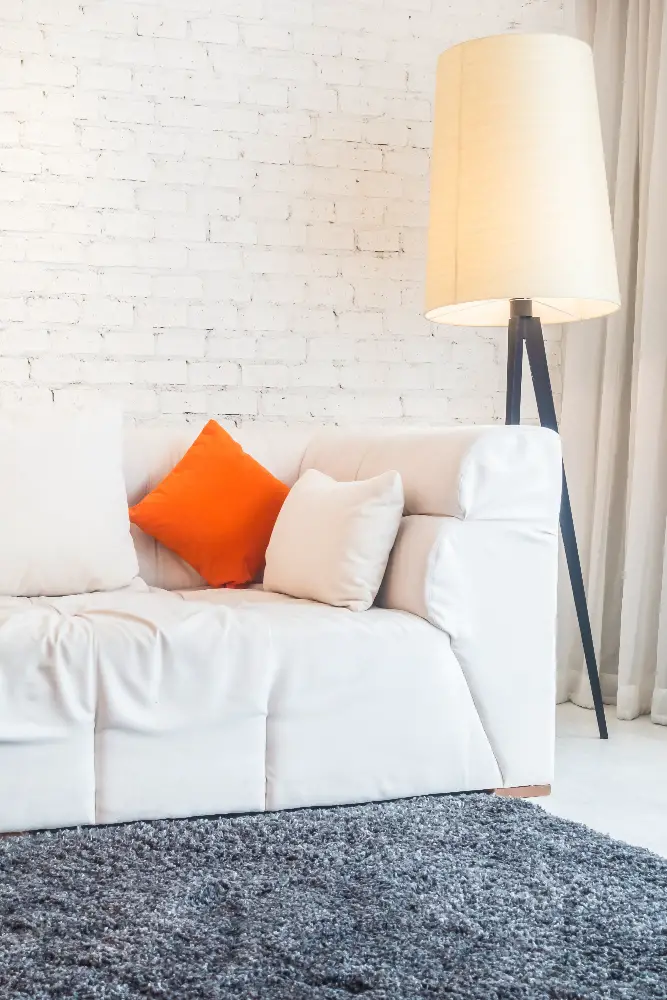
Even well-trained cats can have accidents or moments of weakness where they forget their training and jump on the couch. Here are some tips for protecting your couch:
1. Use a Couch Cover: A slipcover or throw blanket can be an easy way to protect your sofa from scratches and spills.
2. Invest in Scratch-Resistant Furniture: Look for furniture made with durable materials that are resistant to scratching, such as leather or microfiber.
3. Trim Your Cat’s Nails Regularly: Keeping your cat’s nails trimmed will help prevent them from causing damage when they do jump on the couch.
4. Provide Plenty of Scratching Options: Make sure there are plenty of alternative scratching options available for your cat, such as a scratching post or cardboard scratcher.
Regularly Cleaning the Couch
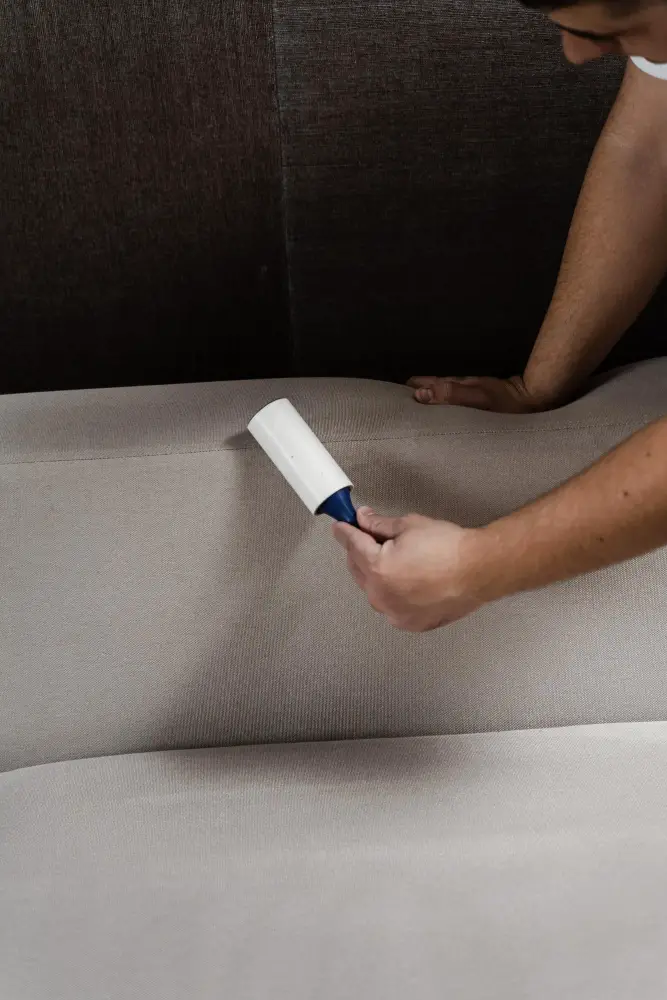
Cats shed a lot, and their fur can easily get trapped in the fibers of your furniture. Vacuuming or using a lint roller on your couch at least once a week can help keep it looking fresh and free from cat hair.
If you notice any scratches or damage to the fabric, address them immediately before they become worse. You may be able to repair minor scratches yourself with some sandpaper and fabric glue.
In addition to cleaning up after your cat, make sure you’re also keeping their litter box clean. A dirty litter box can cause cats stress which could lead them back onto the furniture for comfort.
By following these tips for keeping cats off couches and maintaining cleanliness in your home, you’ll be able to enjoy both quality time with your feline friend as well as an aesthetically pleasing living space that is free from unwanted pet hair and damage!
FAQ
What can I put on my furniture to keep cats off of it?
To keep cats off of your furniture, try spraying a mixture of citrus oil, apple cider vinegar, or peppermint oil with water on the desired areas, but test the spray on a small area first to prevent spots or damage.
Will vinegar keep cats from scratching furniture?
Yes, diluting vinegar in a 50/50 water ratio and spraying it on furniture can deter cats from scratching due to its strong odor.
What type of deterrent spray is effective in keeping cats away from couches?
One type of deterrent spray effective in keeping cats away from couches is a citrus or motion-activated spray.
How can I train my cat to avoid jumping on the couch?
To train your cat to avoid jumping on the couch, use deterrents like aluminum foil or double-sided tape on the couch, while providing alternative high perches nearby for them to climb on instead.
Are there any furniture materials that naturally discourage cats from scratching or sitting on them?
Some furniture materials like leather and microfiber can naturally discourage cats from scratching or sitting on them.




